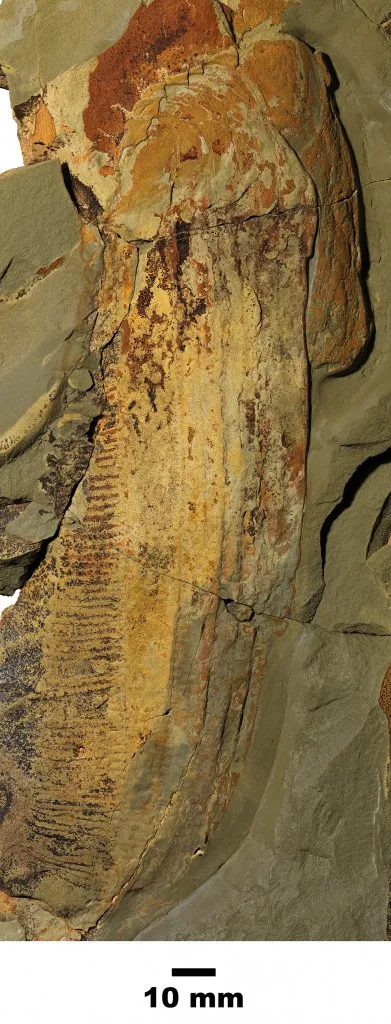Scary Lobster-Like Fossil Was Once One of the Earth’s Largest Animals
One of the earliest arthropods was giant, weird-looking—and played a big role in the course of evolutionary history
/https://tf-cmsv2-smithsonianmag-media.s3.amazonaws.com/filer/9f/b4/9fb42f9f-33ec-4e23-a6af-4172cd160110/1-aegirocassis-benmoulae-reconstruction-feeding.jpg)
The anomalocaridid cruised the planet’s prehistoric oceans some 480 million years ago, and when it existed, it was one of the biggest animals on Earth. It looked like a bizarre cross between a giant squid and a clawless lobster. But this seven-foot behemoth was likely an evolutionary trendsetter—one of the earliest and biggest arthropods ever to exist and responsible for its phylum’s descendants, animals like spiders, butterflies, crabs and centipedes.
Despite its size and somewhat fearsome appearance, it was a gentle filter-feeder, feasting on plankton and other small sea animals using a “comb-like appendage to scoop up the tiny creatures, the way whales do now,” NPR reports. And, as it did when it was alive, the creature is again making waves.
A highly defined anomalocaridids fossil was recently discovered in Morocco’s portion of the Sahara Dessert and described in a paper published by the journal Nature. Unlike previously evaluated fossils from the animal, the new find is in excellent shape—rather than being squashed flat, its features are raised, giving the scientists who carefully excavated its detail from surrounding rock a 3D view of its anatomy.

According to Jenny Marder at PBS Newshour, the specimen’s features—and their implications—startled Yale paleontologist Peter Van Roy, lead author of the Nature paper. Scientists were already aware that anomalocaridids had “appendages used to grab prey or filter plankton from the water and flaps on the sides of their long trunks that were used for swimming.” But they were thought to only have a single set of flaps and no legs whatsoever. But what Van Roy saw were two sets of flaps. Writes Marder:
This discovery of two flaps solved the riddle of the supposedly lost legs in anomalocaridids. For without them, how had modern legs of arthropods evolved? The lower set of flaps seem to be modified legs, Van Roy said, used in the case of these animals for swimming. These flaps, Van Roy and his team believe, are the precursors to walking legs while the upper flaps gave rise to gills found in modern anthropods.

When Van Roy and his team went back to look at other specimens of the creature, they saw evidence of the two flaps that had been previously overlooked. Some experts are now saying that the new information on the specimen, a version of the animal the scientists called Aegirocassis benmoulae, helps to close up “a substantial gap” in our understanding of arthropod evolution.
But what made this “man-sized, swimming centipede,” as NPR called it, so big? Van Roy say that has to do with the era in which it evolved—a time during the Ordovician geological period referred to as the Great Ordovician Biological Diversification Event that marked the “biggest diversification in marine animal life that we've ever known," according to Van Roy. A lot of the new life on earth was plankton, which gave anomalocaridids a good reason to evolve into a filter eater. Scientists theorize that the animal grew huge throughout this period to make it less of an easy object of prey.
"If you're filter-feeding, of course, you probably are not going to be able to defend yourself," Van Roy said according to NPR. "You're not going to have, like, big fangs or anything. So, one way of escaping from predation is just by growing so massive that there's ... simply nothing else that can tackle you."
/https://tf-cmsv2-smithsonianmag-media.s3.amazonaws.com/accounts/headshot/lauraclark.jpeg)
/https://tf-cmsv2-smithsonianmag-media.s3.amazonaws.com/accounts/headshot/lauraclark.jpeg)